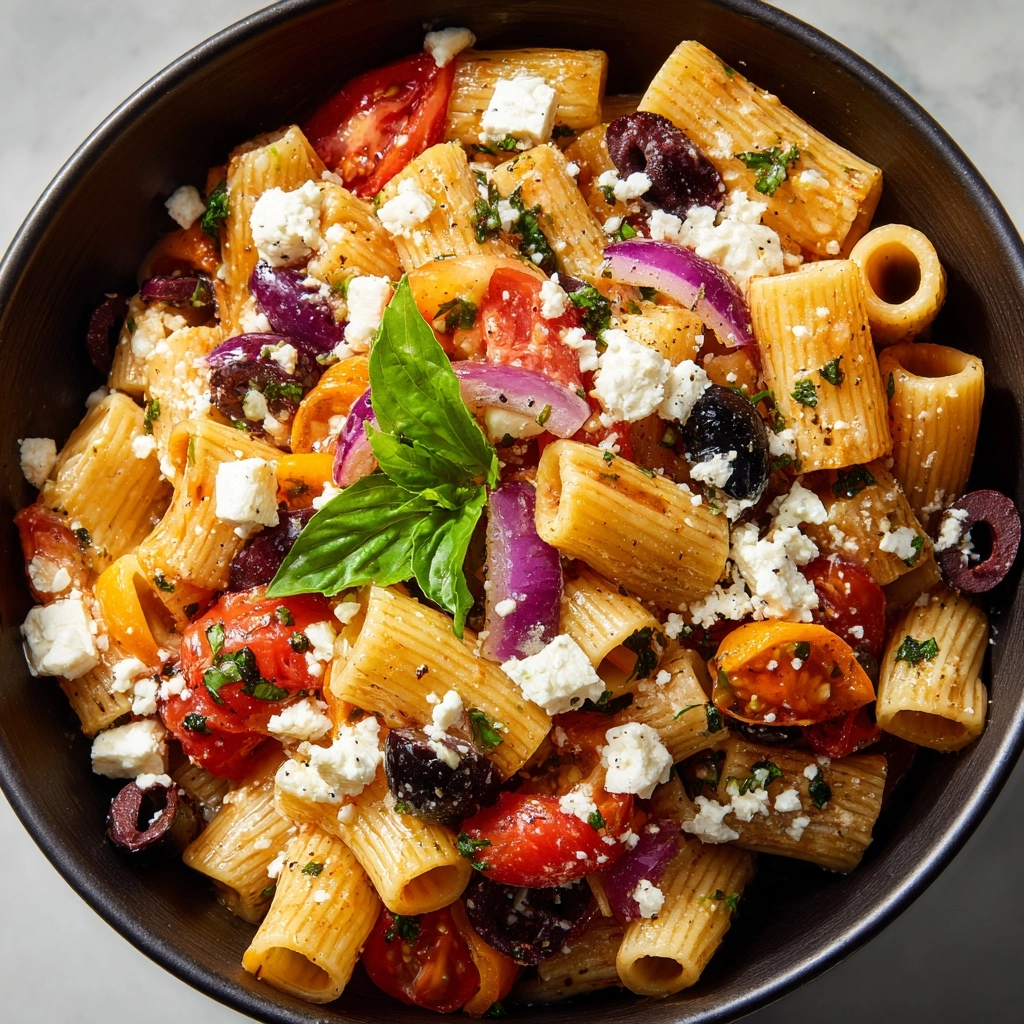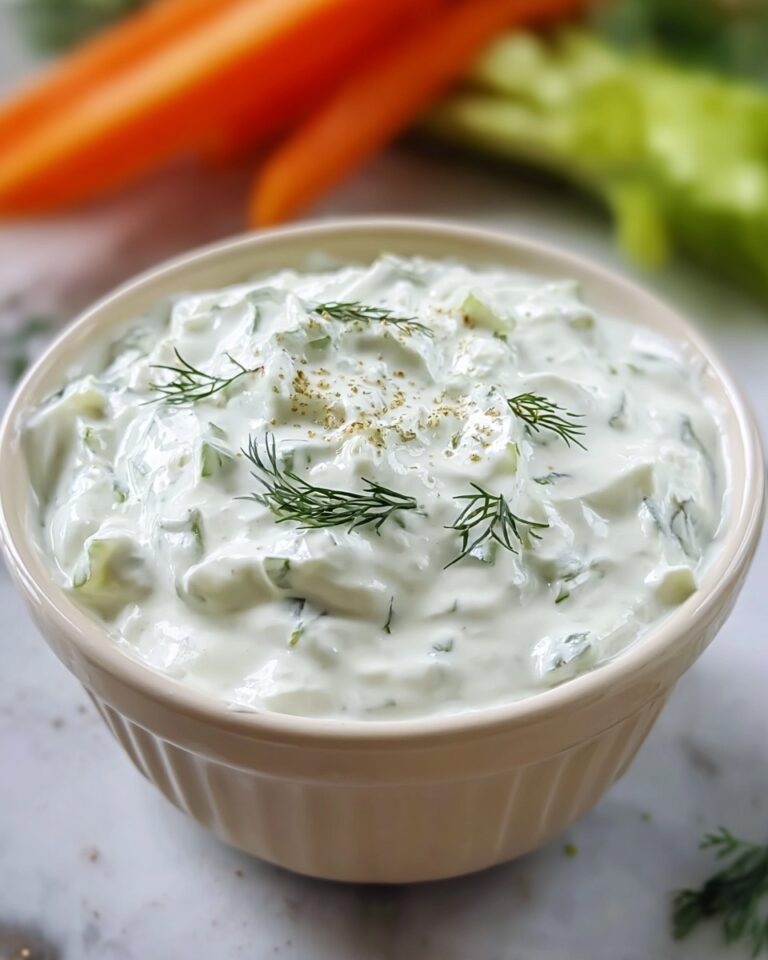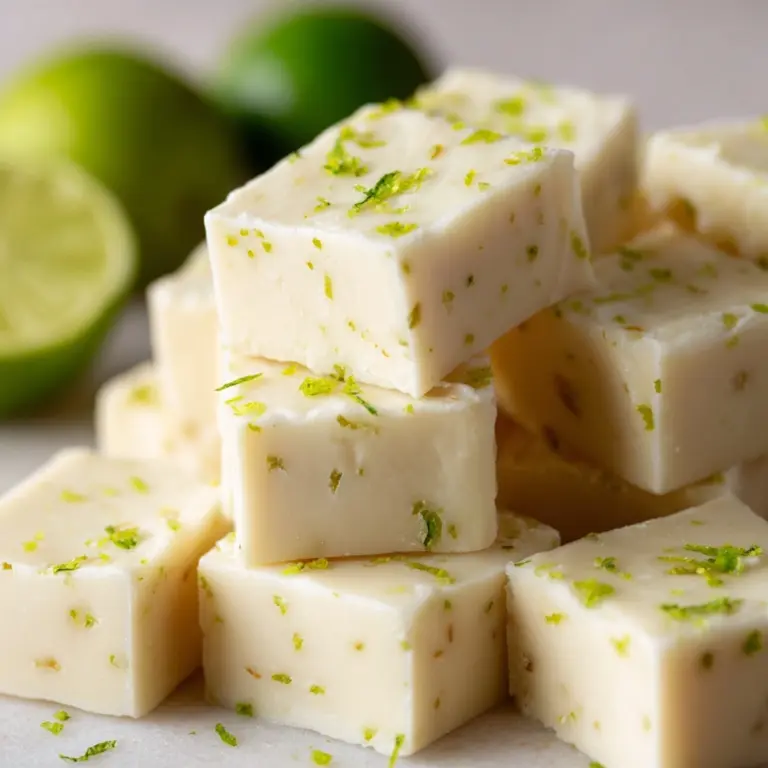Greek Pasta Salad is the kind of dish that whisks you straight to a sun-soaked terrace overlooking the Aegean, bursting with classic Mediterranean flavors and a rainbow of crisp veggies. With tender pasta, juicy cherry tomatoes, cool cucumbers, briny olives, and tangy feta, every bite sings with freshness. Tossed in a lively red wine vinaigrette, it’s equally perfect for picnics, potlucks, or simple weeknight dinners. If you’ve been searching for a side that steals the show (and is jaw-droppingly easy to assemble), this is a recipe you’ll want to add to your regular lineup.
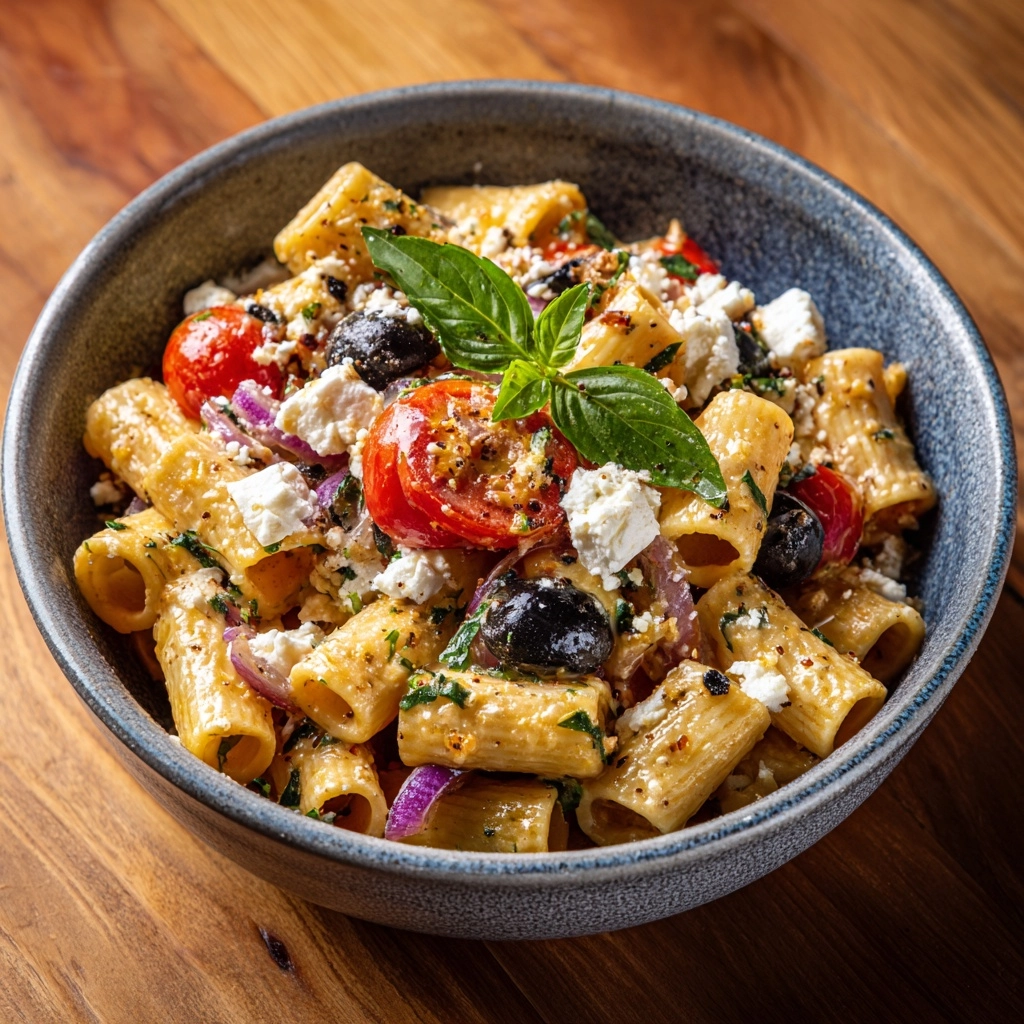
Ingredients You’ll Need
There’s beauty in the simplicity of these ingredients; each one brings its own vivid color, flavor, and vitality to the Greek Pasta Salad. Try not to skip a thing—together, they make this salad truly sing!
- Pasta (12 oz rotini or penne): The spirals or tubes perfectly hold onto the vinaigrette and bits of vegetables for maximum flavor in every forkful.
- Cherry tomatoes (1 cup, halved): Choose the ripest, juiciest tomatoes for a burst of sweetness and gorgeous red color.
- Cucumber (1 cup, diced): Cool, crisp cucumber adds crunch and balances out the briny flavors.
- Red onion (1/2 cup, thinly sliced): Sliced thin, red onion gives a peppery bite and an appealing punch of color.
- Kalamata olives (3/4 cup, halved): Their salty, wine-like taste is undeniable—the soul of this Mediterranean salad.
- Feta cheese (1 cup, crumbled): Tangy, creamy feta rounds out the flavors and delivers richness to every bite.
- Fresh parsley (1/4 cup, chopped): The sprinkle of greens brings an herby freshness that lightens the salad beautifully.
- Extra virgin olive oil (1/3 cup): Use your best olive oil—it makes the dressing shine and ties all the ingredients together.
- Red wine vinegar (2 tablespoons): This splashy acid brightens and balances the salad without overpowering it.
- Lemon juice (1 tablespoon): Fresh-squeezed is best, adding sparkle and zing to the vinaigrette.
- Dried oregano (1 teaspoon): The essential herb for authentic Greek flavor—don’t be shy.
- Salt and black pepper (to taste): Season just enough to enhance but not overwhelm; it ties the whole bowl together.
How to Make Greek Pasta Salad
Step 1: Cook the Pasta
Start by bringing a big pot of salted water to a rolling boil. Add your rotini or penne and cook until perfectly al dente—usually about 10 minutes, but always check your package instructions to be sure. Once the noodles have reached just the right texture, drain them, and rinse under cold water right away. That rinse stops the cooking in its tracks and keeps the pasta from sticking together. Spread it out a little if you want that extra guarantee every noodle stays separate and ready for dressing.
Step 2: Chop and Combine the Veggies
While the pasta is cooking and cooling, wash and chop your veggies: halve those juicy cherry tomatoes, dice the cucumber for crunch, and thinly slice the red onion so it melds easily with the other flavors. The Kalamata olives should be pitted and halved for easy eating, and the parsley chopped to a fine confetti. Add all these beautiful ingredients, along with the creamy feta, to your largest mixing bowl—you want plenty of room for tossing.
Step 3: Whisk the Dressing
In a small bowl or mason jar, combine extra virgin olive oil, red wine vinegar, lemon juice, dried oregano, plus a generous pinch of salt and black pepper. Whisk until the dressing is fully emulsified and the herbs are beautifully floating throughout, or shake your jar with the lid on for a minute if you prefer.
Step 4: Toss Everything Together
Pour the aromatic dressing right over your bowl of pasta and vegetables. Now, toss gently but thoroughly, making sure every nook and cranny of pasta gets coated and the veggies stay vibrant and intact. Don’t be afraid to use your hands at the end for the most even toss! Sprinkle the chopped parsley over the top to finish this Greek Pasta Salad with a flourish.
Step 5: Chill and Serve
Transfer the mixed salad to the refrigerator and let it chill for at least 30 minutes. This bit of patience pays off—every ingredient has time to soak up the zesty dressing, turning the flavors into something even more magical. Serve the Greek Pasta Salad cold or let it come to room temperature (just 10 minutes out of the fridge is plenty). Both versions are spectacularly delicious.
How to Serve Greek Pasta Salad
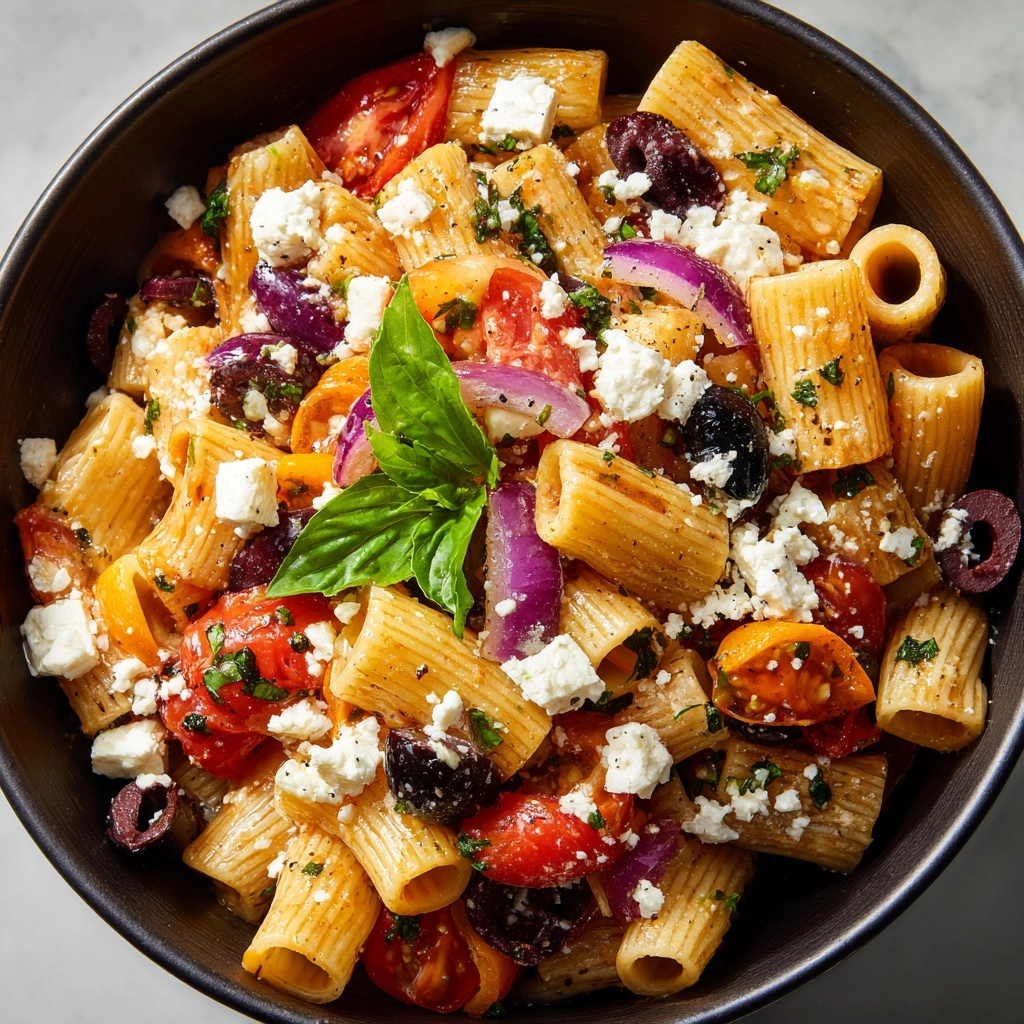
Garnishes
Classic garnishes make this dish even more inviting! A scatter of extra feta, a sprinkle of fresh parsley, or a few reserved Kalamata olives right before serving adds a burst of color and flavor. You might also try a grind of black pepper or a drizzle of olive oil for that Mediterranean finish. Whatever you choose, garnishes turn a simple Greek Pasta Salad into a true centerpiece.
Side Dishes
Pair this vibrant salad with warm pita bread, hummus, or even dolmas (stuffed grape leaves) for a complete Greek-inspired feast. It’s also an ideal companion to grilled chicken, seared shrimp, or tender lamb skewers. Since Greek Pasta Salad is so versatile, it complements nearly any protein or side you love.
Creative Ways to Present
Serving Greek Pasta Salad in individual mason jars makes a portable lunch for picnics and barbecues. For parties, pile it onto a bed of leafy spinach and adorn it with lemon wedges for a pop of color. You can even stuff the salad into halved bell peppers or serve in endive leaves for a fun, hand-held appetizer that impresses every guest.
Make Ahead and Storage
Storing Leftovers
If you’re lucky enough to have leftovers, Greek Pasta Salad stores beautifully. Keep it in an airtight container in the refrigerator, and it’ll taste just as vibrant up to three days later. The flavors actually meld and grow richer the longer they rest, making this salad a dream for meal prep.
Freezing
Freezing is not recommended for Greek Pasta Salad. The fresh vegetables will lose their crispness and the feta’s texture can change once thawed. For best results, enjoy it freshly made or straight from the fridge within a few days.
Reheating
Greek Pasta Salad is meant to be served cold or at room temperature. If you’d like to take the chill off, simply let it sit out for about 10 minutes before serving. No reheating necessary, making it perfect for potlucks, picnics, or lunches on the go!
FAQs
Can I make Greek Pasta Salad in advance?
Absolutely! In fact, the flavors deepen and meld when the salad is made a day ahead. Just give it a good toss before serving, and feel free to refresh it with a little extra olive oil or lemon juice if it seems a bit dry from chilling.
What pasta shapes work best for Greek Pasta Salad?
Rotini and penne are top choices because their shapes clutch onto the dressing and small diced veggies. However, fusilli, farfalle, or even orzo work nicely, so feel free to use your favorite short pasta for the job.
How can I make Greek Pasta Salad gluten-free?
It’s easy! Simply swap in your favorite gluten-free rotini or penne. There are great options made from rice, chickpeas, or lentils that pair well with the zesty, vibrant flavors in this salad.
Can I add protein to Greek Pasta Salad?
Definitely! Try tossing in grilled chicken, cooked shrimp, canned tuna, or chickpeas to transform this side into a satisfying main. It’s a fun way to bulk up the meal while keeping things fresh and light.
How long does Greek Pasta Salad keep?
Greek Pasta Salad will stay fresh in the refrigerator for up to three days. If the salad seems dry after sitting, revive it with a splash of olive oil or a squeeze of lemon before serving. It’s just as tasty after it rests—if not better!
Final Thoughts
If you’ve been craving something bright, hearty, and endlessly adaptable, Greek Pasta Salad is your new go-to dish. I can’t wait for you to experience how easy and delicious it is—this is a salad that will keep people coming back for seconds every single time. Enjoy making it, sharing it, and claiming the leftovers for lunch!

